Mental Health in Older People: Diagnosis, Medications, Treatment, and Care
VerifiedAdded on 2023/06/10
|15
|4438
|126
AI Summary
This case study explores the diagnosis, medications, treatment, and care of an older patient with mental health issues. It covers the use of Addenbrooke's Cognitive Examination III, therapeutic engagement, and meal assistance.
Contribute Materials
Your contribution can guide someone’s learning journey. Share your
documents today.

Running head: CASE STUDY
Mental health in older people
Name of the Student
Name of the University
Author Note
Mental health in older people
Name of the Student
Name of the University
Author Note
Secure Best Marks with AI Grader
Need help grading? Try our AI Grader for instant feedback on your assignments.
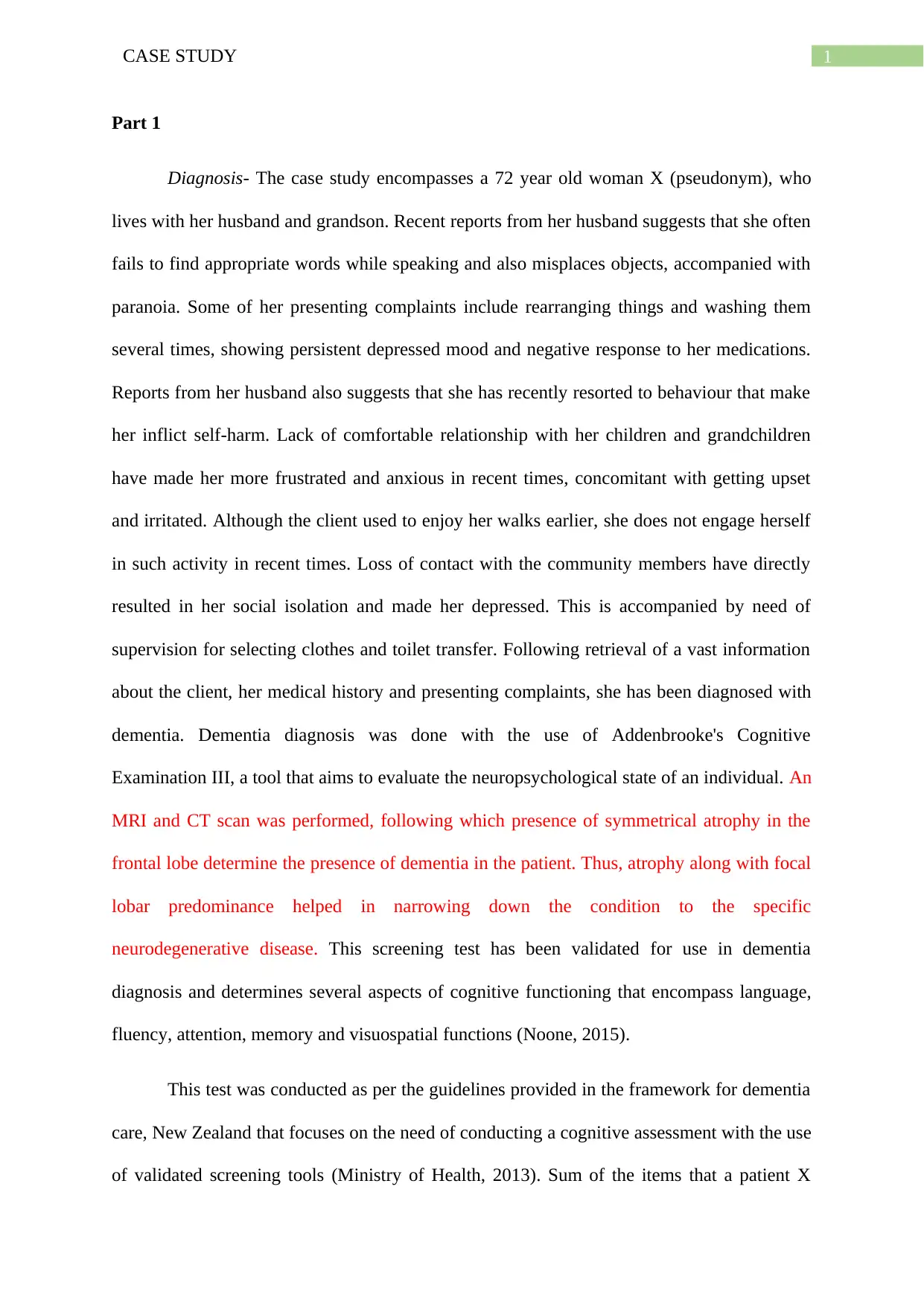
1CASE STUDY
Part 1
Diagnosis- The case study encompasses a 72 year old woman X (pseudonym), who
lives with her husband and grandson. Recent reports from her husband suggests that she often
fails to find appropriate words while speaking and also misplaces objects, accompanied with
paranoia. Some of her presenting complaints include rearranging things and washing them
several times, showing persistent depressed mood and negative response to her medications.
Reports from her husband also suggests that she has recently resorted to behaviour that make
her inflict self-harm. Lack of comfortable relationship with her children and grandchildren
have made her more frustrated and anxious in recent times, concomitant with getting upset
and irritated. Although the client used to enjoy her walks earlier, she does not engage herself
in such activity in recent times. Loss of contact with the community members have directly
resulted in her social isolation and made her depressed. This is accompanied by need of
supervision for selecting clothes and toilet transfer. Following retrieval of a vast information
about the client, her medical history and presenting complaints, she has been diagnosed with
dementia. Dementia diagnosis was done with the use of Addenbrooke's Cognitive
Examination III, a tool that aims to evaluate the neuropsychological state of an individual. An
MRI and CT scan was performed, following which presence of symmetrical atrophy in the
frontal lobe determine the presence of dementia in the patient. Thus, atrophy along with focal
lobar predominance helped in narrowing down the condition to the specific
neurodegenerative disease. This screening test has been validated for use in dementia
diagnosis and determines several aspects of cognitive functioning that encompass language,
fluency, attention, memory and visuospatial functions (Noone, 2015).
This test was conducted as per the guidelines provided in the framework for dementia
care, New Zealand that focuses on the need of conducting a cognitive assessment with the use
of validated screening tools (Ministry of Health, 2013). Sum of the items that a patient X
Part 1
Diagnosis- The case study encompasses a 72 year old woman X (pseudonym), who
lives with her husband and grandson. Recent reports from her husband suggests that she often
fails to find appropriate words while speaking and also misplaces objects, accompanied with
paranoia. Some of her presenting complaints include rearranging things and washing them
several times, showing persistent depressed mood and negative response to her medications.
Reports from her husband also suggests that she has recently resorted to behaviour that make
her inflict self-harm. Lack of comfortable relationship with her children and grandchildren
have made her more frustrated and anxious in recent times, concomitant with getting upset
and irritated. Although the client used to enjoy her walks earlier, she does not engage herself
in such activity in recent times. Loss of contact with the community members have directly
resulted in her social isolation and made her depressed. This is accompanied by need of
supervision for selecting clothes and toilet transfer. Following retrieval of a vast information
about the client, her medical history and presenting complaints, she has been diagnosed with
dementia. Dementia diagnosis was done with the use of Addenbrooke's Cognitive
Examination III, a tool that aims to evaluate the neuropsychological state of an individual. An
MRI and CT scan was performed, following which presence of symmetrical atrophy in the
frontal lobe determine the presence of dementia in the patient. Thus, atrophy along with focal
lobar predominance helped in narrowing down the condition to the specific
neurodegenerative disease. This screening test has been validated for use in dementia
diagnosis and determines several aspects of cognitive functioning that encompass language,
fluency, attention, memory and visuospatial functions (Noone, 2015).
This test was conducted as per the guidelines provided in the framework for dementia
care, New Zealand that focuses on the need of conducting a cognitive assessment with the use
of validated screening tools (Ministry of Health, 2013). Sum of the items that a patient X
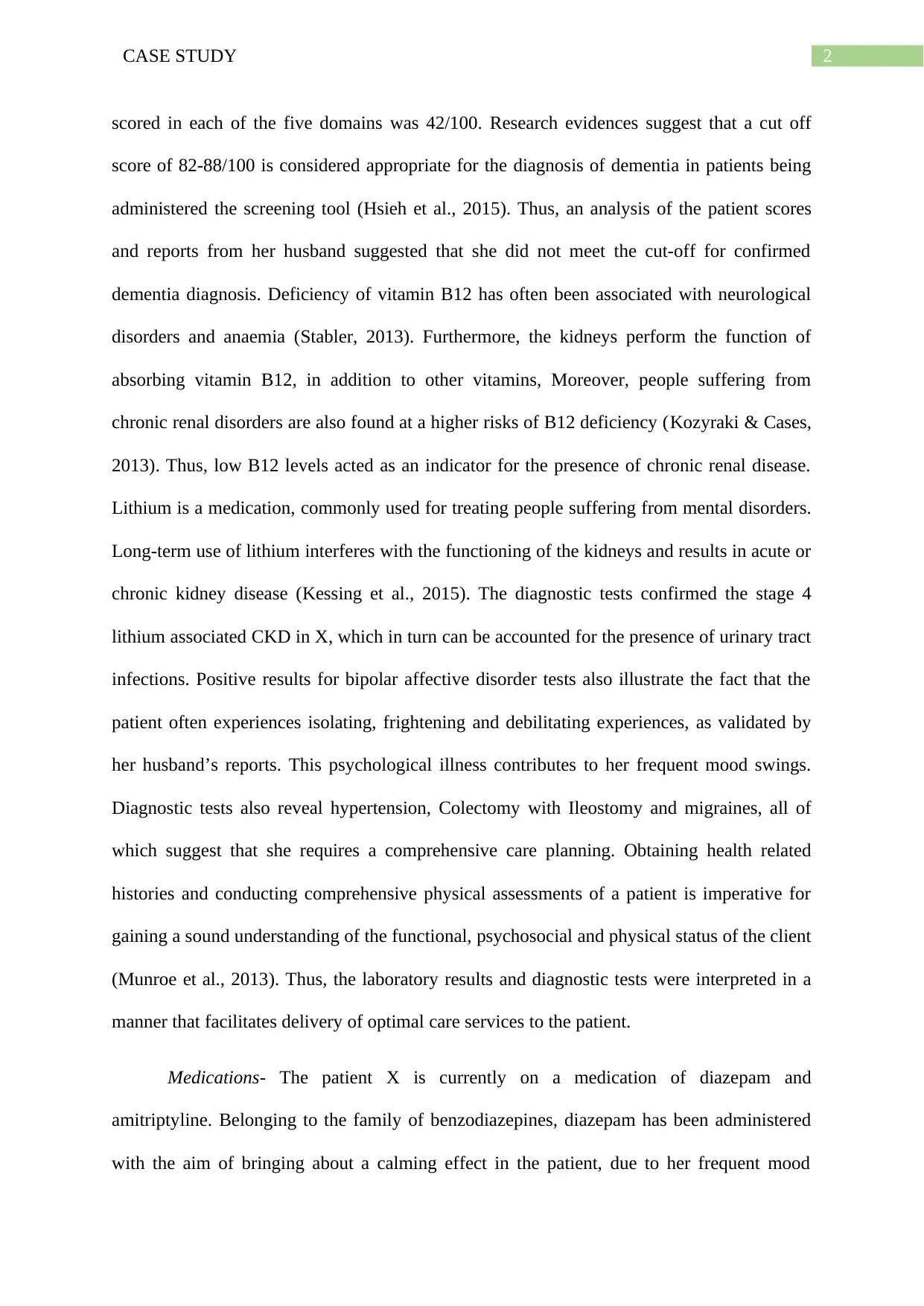
2CASE STUDY
scored in each of the five domains was 42/100. Research evidences suggest that a cut off
score of 82-88/100 is considered appropriate for the diagnosis of dementia in patients being
administered the screening tool (Hsieh et al., 2015). Thus, an analysis of the patient scores
and reports from her husband suggested that she did not meet the cut-off for confirmed
dementia diagnosis. Deficiency of vitamin B12 has often been associated with neurological
disorders and anaemia (Stabler, 2013). Furthermore, the kidneys perform the function of
absorbing vitamin B12, in addition to other vitamins, Moreover, people suffering from
chronic renal disorders are also found at a higher risks of B12 deficiency (Kozyraki & Cases,
2013). Thus, low B12 levels acted as an indicator for the presence of chronic renal disease.
Lithium is a medication, commonly used for treating people suffering from mental disorders.
Long-term use of lithium interferes with the functioning of the kidneys and results in acute or
chronic kidney disease (Kessing et al., 2015). The diagnostic tests confirmed the stage 4
lithium associated CKD in X, which in turn can be accounted for the presence of urinary tract
infections. Positive results for bipolar affective disorder tests also illustrate the fact that the
patient often experiences isolating, frightening and debilitating experiences, as validated by
her husband’s reports. This psychological illness contributes to her frequent mood swings.
Diagnostic tests also reveal hypertension, Colectomy with Ileostomy and migraines, all of
which suggest that she requires a comprehensive care planning. Obtaining health related
histories and conducting comprehensive physical assessments of a patient is imperative for
gaining a sound understanding of the functional, psychosocial and physical status of the client
(Munroe et al., 2013). Thus, the laboratory results and diagnostic tests were interpreted in a
manner that facilitates delivery of optimal care services to the patient.
Medications- The patient X is currently on a medication of diazepam and
amitriptyline. Belonging to the family of benzodiazepines, diazepam has been administered
with the aim of bringing about a calming effect in the patient, due to her frequent mood
scored in each of the five domains was 42/100. Research evidences suggest that a cut off
score of 82-88/100 is considered appropriate for the diagnosis of dementia in patients being
administered the screening tool (Hsieh et al., 2015). Thus, an analysis of the patient scores
and reports from her husband suggested that she did not meet the cut-off for confirmed
dementia diagnosis. Deficiency of vitamin B12 has often been associated with neurological
disorders and anaemia (Stabler, 2013). Furthermore, the kidneys perform the function of
absorbing vitamin B12, in addition to other vitamins, Moreover, people suffering from
chronic renal disorders are also found at a higher risks of B12 deficiency (Kozyraki & Cases,
2013). Thus, low B12 levels acted as an indicator for the presence of chronic renal disease.
Lithium is a medication, commonly used for treating people suffering from mental disorders.
Long-term use of lithium interferes with the functioning of the kidneys and results in acute or
chronic kidney disease (Kessing et al., 2015). The diagnostic tests confirmed the stage 4
lithium associated CKD in X, which in turn can be accounted for the presence of urinary tract
infections. Positive results for bipolar affective disorder tests also illustrate the fact that the
patient often experiences isolating, frightening and debilitating experiences, as validated by
her husband’s reports. This psychological illness contributes to her frequent mood swings.
Diagnostic tests also reveal hypertension, Colectomy with Ileostomy and migraines, all of
which suggest that she requires a comprehensive care planning. Obtaining health related
histories and conducting comprehensive physical assessments of a patient is imperative for
gaining a sound understanding of the functional, psychosocial and physical status of the client
(Munroe et al., 2013). Thus, the laboratory results and diagnostic tests were interpreted in a
manner that facilitates delivery of optimal care services to the patient.
Medications- The patient X is currently on a medication of diazepam and
amitriptyline. Belonging to the family of benzodiazepines, diazepam has been administered
with the aim of bringing about a calming effect in the patient, due to her frequent mood
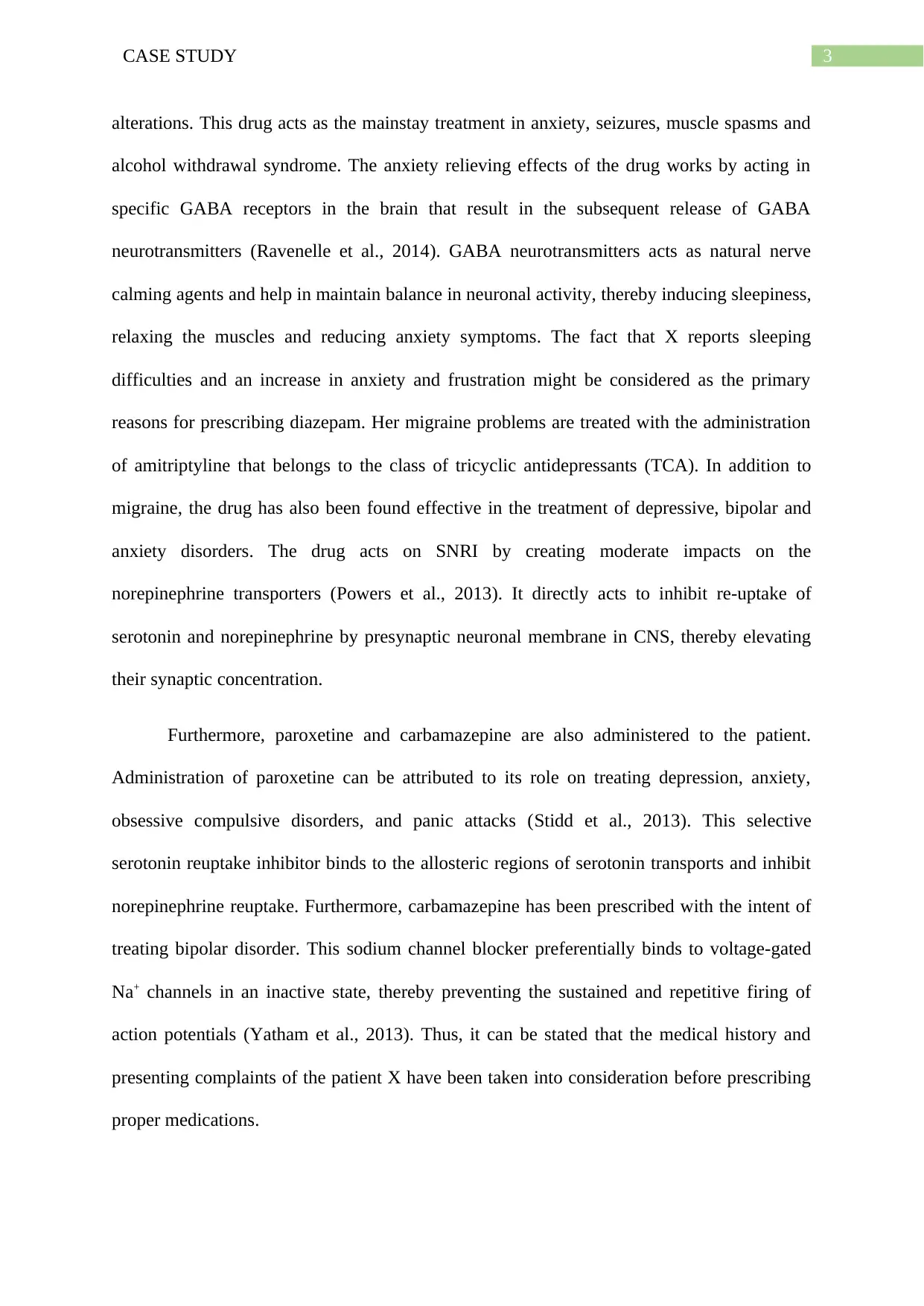
3CASE STUDY
alterations. This drug acts as the mainstay treatment in anxiety, seizures, muscle spasms and
alcohol withdrawal syndrome. The anxiety relieving effects of the drug works by acting in
specific GABA receptors in the brain that result in the subsequent release of GABA
neurotransmitters (Ravenelle et al., 2014). GABA neurotransmitters acts as natural nerve
calming agents and help in maintain balance in neuronal activity, thereby inducing sleepiness,
relaxing the muscles and reducing anxiety symptoms. The fact that X reports sleeping
difficulties and an increase in anxiety and frustration might be considered as the primary
reasons for prescribing diazepam. Her migraine problems are treated with the administration
of amitriptyline that belongs to the class of tricyclic antidepressants (TCA). In addition to
migraine, the drug has also been found effective in the treatment of depressive, bipolar and
anxiety disorders. The drug acts on SNRI by creating moderate impacts on the
norepinephrine transporters (Powers et al., 2013). It directly acts to inhibit re-uptake of
serotonin and norepinephrine by presynaptic neuronal membrane in CNS, thereby elevating
their synaptic concentration.
Furthermore, paroxetine and carbamazepine are also administered to the patient.
Administration of paroxetine can be attributed to its role on treating depression, anxiety,
obsessive compulsive disorders, and panic attacks (Stidd et al., 2013). This selective
serotonin reuptake inhibitor binds to the allosteric regions of serotonin transports and inhibit
norepinephrine reuptake. Furthermore, carbamazepine has been prescribed with the intent of
treating bipolar disorder. This sodium channel blocker preferentially binds to voltage-gated
Na+ channels in an inactive state, thereby preventing the sustained and repetitive firing of
action potentials (Yatham et al., 2013). Thus, it can be stated that the medical history and
presenting complaints of the patient X have been taken into consideration before prescribing
proper medications.
alterations. This drug acts as the mainstay treatment in anxiety, seizures, muscle spasms and
alcohol withdrawal syndrome. The anxiety relieving effects of the drug works by acting in
specific GABA receptors in the brain that result in the subsequent release of GABA
neurotransmitters (Ravenelle et al., 2014). GABA neurotransmitters acts as natural nerve
calming agents and help in maintain balance in neuronal activity, thereby inducing sleepiness,
relaxing the muscles and reducing anxiety symptoms. The fact that X reports sleeping
difficulties and an increase in anxiety and frustration might be considered as the primary
reasons for prescribing diazepam. Her migraine problems are treated with the administration
of amitriptyline that belongs to the class of tricyclic antidepressants (TCA). In addition to
migraine, the drug has also been found effective in the treatment of depressive, bipolar and
anxiety disorders. The drug acts on SNRI by creating moderate impacts on the
norepinephrine transporters (Powers et al., 2013). It directly acts to inhibit re-uptake of
serotonin and norepinephrine by presynaptic neuronal membrane in CNS, thereby elevating
their synaptic concentration.
Furthermore, paroxetine and carbamazepine are also administered to the patient.
Administration of paroxetine can be attributed to its role on treating depression, anxiety,
obsessive compulsive disorders, and panic attacks (Stidd et al., 2013). This selective
serotonin reuptake inhibitor binds to the allosteric regions of serotonin transports and inhibit
norepinephrine reuptake. Furthermore, carbamazepine has been prescribed with the intent of
treating bipolar disorder. This sodium channel blocker preferentially binds to voltage-gated
Na+ channels in an inactive state, thereby preventing the sustained and repetitive firing of
action potentials (Yatham et al., 2013). Thus, it can be stated that the medical history and
presenting complaints of the patient X have been taken into consideration before prescribing
proper medications.
Secure Best Marks with AI Grader
Need help grading? Try our AI Grader for instant feedback on your assignments.
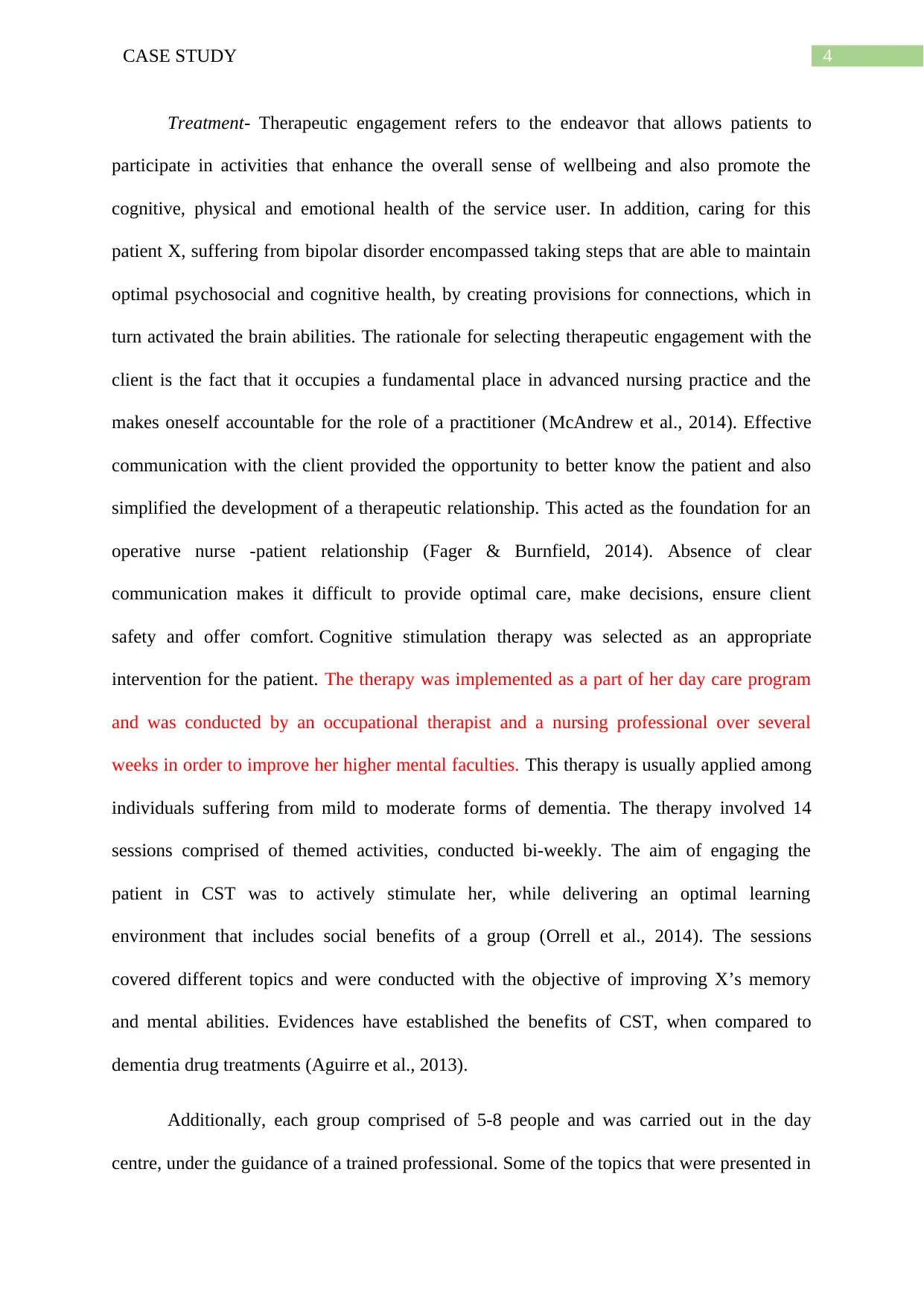
4CASE STUDY
Treatment- Therapeutic engagement refers to the endeavor that allows patients to
participate in activities that enhance the overall sense of wellbeing and also promote the
cognitive, physical and emotional health of the service user. In addition, caring for this
patient X, suffering from bipolar disorder encompassed taking steps that are able to maintain
optimal psychosocial and cognitive health, by creating provisions for connections, which in
turn activated the brain abilities. The rationale for selecting therapeutic engagement with the
client is the fact that it occupies a fundamental place in advanced nursing practice and the
makes oneself accountable for the role of a practitioner (McAndrew et al., 2014). Effective
communication with the client provided the opportunity to better know the patient and also
simplified the development of a therapeutic relationship. This acted as the foundation for an
operative nurse -patient relationship (Fager & Burnfield, 2014). Absence of clear
communication makes it difficult to provide optimal care, make decisions, ensure client
safety and offer comfort. Cognitive stimulation therapy was selected as an appropriate
intervention for the patient. The therapy was implemented as a part of her day care program
and was conducted by an occupational therapist and a nursing professional over several
weeks in order to improve her higher mental faculties. This therapy is usually applied among
individuals suffering from mild to moderate forms of dementia. The therapy involved 14
sessions comprised of themed activities, conducted bi-weekly. The aim of engaging the
patient in CST was to actively stimulate her, while delivering an optimal learning
environment that includes social benefits of a group (Orrell et al., 2014). The sessions
covered different topics and were conducted with the objective of improving X’s memory
and mental abilities. Evidences have established the benefits of CST, when compared to
dementia drug treatments (Aguirre et al., 2013).
Additionally, each group comprised of 5-8 people and was carried out in the day
centre, under the guidance of a trained professional. Some of the topics that were presented in
Treatment- Therapeutic engagement refers to the endeavor that allows patients to
participate in activities that enhance the overall sense of wellbeing and also promote the
cognitive, physical and emotional health of the service user. In addition, caring for this
patient X, suffering from bipolar disorder encompassed taking steps that are able to maintain
optimal psychosocial and cognitive health, by creating provisions for connections, which in
turn activated the brain abilities. The rationale for selecting therapeutic engagement with the
client is the fact that it occupies a fundamental place in advanced nursing practice and the
makes oneself accountable for the role of a practitioner (McAndrew et al., 2014). Effective
communication with the client provided the opportunity to better know the patient and also
simplified the development of a therapeutic relationship. This acted as the foundation for an
operative nurse -patient relationship (Fager & Burnfield, 2014). Absence of clear
communication makes it difficult to provide optimal care, make decisions, ensure client
safety and offer comfort. Cognitive stimulation therapy was selected as an appropriate
intervention for the patient. The therapy was implemented as a part of her day care program
and was conducted by an occupational therapist and a nursing professional over several
weeks in order to improve her higher mental faculties. This therapy is usually applied among
individuals suffering from mild to moderate forms of dementia. The therapy involved 14
sessions comprised of themed activities, conducted bi-weekly. The aim of engaging the
patient in CST was to actively stimulate her, while delivering an optimal learning
environment that includes social benefits of a group (Orrell et al., 2014). The sessions
covered different topics and were conducted with the objective of improving X’s memory
and mental abilities. Evidences have established the benefits of CST, when compared to
dementia drug treatments (Aguirre et al., 2013).
Additionally, each group comprised of 5-8 people and was carried out in the day
centre, under the guidance of a trained professional. Some of the topics that were presented in

5CASE STUDY
the sessions include food, childhood, current affairs, and monetary transactions. Efforts were
taken to provide a supportive atmosphere where the patient was made to conduct the
activities, which stimulated multi-sensory experiences. CST was an effective strategy in
enhancing higher mental faculties and also creates significant effects on skills associated with
language such as, comprehension, word-finding and naming. The treatment programs also
encompassed weekly walking support. Longevity has been found to create negative impacts
on the mobility of older person and rehabilitation interventions often have the potential of
holding back rates of functional decline, thereby preventing the mobility of older patients
(Rosso et al., 2013). Thus, the walking support program acted as a major step that contributed
to the procedure of maintaining mobility of X. All efforts were taken to maintain safety of the
patient and prevent all forms of unintended injuries and harms. The treatment took into
consideration the fact that older adults staying active and successful in maintaining their
functional abilities have enhanced quality of life. Functional abilities commonly encompass
self-care activity performance, and are also governed by the capability of the affected
individual to mobilise. Thus, the walking support program was initiated with the aim of
assisting the patient X to walk, stand, change position, move or sit.
This structured rehabilitation program had the capacity of preventing the deterioration
in mobility. Thus, the weekly walks with support was advantageous to the wellbeing of the
patient and enabled her to get mobilised on a regular basis. Furthermore, the role of personal
care assistants or caregivers encompass providing aid to patients who are ill, fragile, and
physically or mental disabled (Griffiths et al., 2013). In other words, the past medical history
and presenting complaints of X were considered to provide her assistance in regular small
and big tasks. Assistance was provided to her to help with activities that involved bathing,
dressing, and medication administration, transferring in and out of the bed, physical therapy,
the sessions include food, childhood, current affairs, and monetary transactions. Efforts were
taken to provide a supportive atmosphere where the patient was made to conduct the
activities, which stimulated multi-sensory experiences. CST was an effective strategy in
enhancing higher mental faculties and also creates significant effects on skills associated with
language such as, comprehension, word-finding and naming. The treatment programs also
encompassed weekly walking support. Longevity has been found to create negative impacts
on the mobility of older person and rehabilitation interventions often have the potential of
holding back rates of functional decline, thereby preventing the mobility of older patients
(Rosso et al., 2013). Thus, the walking support program acted as a major step that contributed
to the procedure of maintaining mobility of X. All efforts were taken to maintain safety of the
patient and prevent all forms of unintended injuries and harms. The treatment took into
consideration the fact that older adults staying active and successful in maintaining their
functional abilities have enhanced quality of life. Functional abilities commonly encompass
self-care activity performance, and are also governed by the capability of the affected
individual to mobilise. Thus, the walking support program was initiated with the aim of
assisting the patient X to walk, stand, change position, move or sit.
This structured rehabilitation program had the capacity of preventing the deterioration
in mobility. Thus, the weekly walks with support was advantageous to the wellbeing of the
patient and enabled her to get mobilised on a regular basis. Furthermore, the role of personal
care assistants or caregivers encompass providing aid to patients who are ill, fragile, and
physically or mental disabled (Griffiths et al., 2013). In other words, the past medical history
and presenting complaints of X were considered to provide her assistance in regular small
and big tasks. Assistance was provided to her to help with activities that involved bathing,
dressing, and medication administration, transferring in and out of the bed, physical therapy,
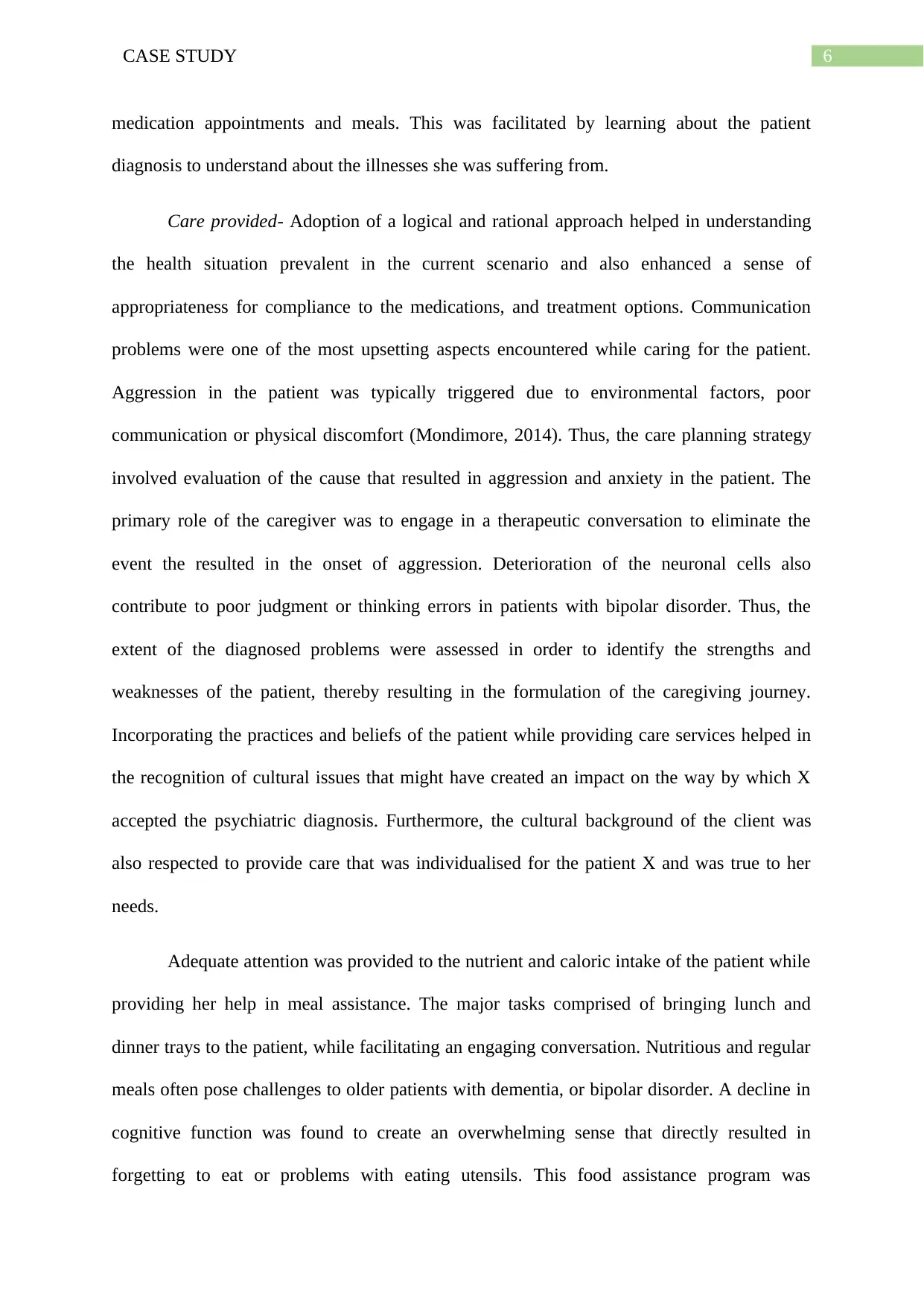
6CASE STUDY
medication appointments and meals. This was facilitated by learning about the patient
diagnosis to understand about the illnesses she was suffering from.
Care provided- Adoption of a logical and rational approach helped in understanding
the health situation prevalent in the current scenario and also enhanced a sense of
appropriateness for compliance to the medications, and treatment options. Communication
problems were one of the most upsetting aspects encountered while caring for the patient.
Aggression in the patient was typically triggered due to environmental factors, poor
communication or physical discomfort (Mondimore, 2014). Thus, the care planning strategy
involved evaluation of the cause that resulted in aggression and anxiety in the patient. The
primary role of the caregiver was to engage in a therapeutic conversation to eliminate the
event the resulted in the onset of aggression. Deterioration of the neuronal cells also
contribute to poor judgment or thinking errors in patients with bipolar disorder. Thus, the
extent of the diagnosed problems were assessed in order to identify the strengths and
weaknesses of the patient, thereby resulting in the formulation of the caregiving journey.
Incorporating the practices and beliefs of the patient while providing care services helped in
the recognition of cultural issues that might have created an impact on the way by which X
accepted the psychiatric diagnosis. Furthermore, the cultural background of the client was
also respected to provide care that was individualised for the patient X and was true to her
needs.
Adequate attention was provided to the nutrient and caloric intake of the patient while
providing her help in meal assistance. The major tasks comprised of bringing lunch and
dinner trays to the patient, while facilitating an engaging conversation. Nutritious and regular
meals often pose challenges to older patients with dementia, or bipolar disorder. A decline in
cognitive function was found to create an overwhelming sense that directly resulted in
forgetting to eat or problems with eating utensils. This food assistance program was
medication appointments and meals. This was facilitated by learning about the patient
diagnosis to understand about the illnesses she was suffering from.
Care provided- Adoption of a logical and rational approach helped in understanding
the health situation prevalent in the current scenario and also enhanced a sense of
appropriateness for compliance to the medications, and treatment options. Communication
problems were one of the most upsetting aspects encountered while caring for the patient.
Aggression in the patient was typically triggered due to environmental factors, poor
communication or physical discomfort (Mondimore, 2014). Thus, the care planning strategy
involved evaluation of the cause that resulted in aggression and anxiety in the patient. The
primary role of the caregiver was to engage in a therapeutic conversation to eliminate the
event the resulted in the onset of aggression. Deterioration of the neuronal cells also
contribute to poor judgment or thinking errors in patients with bipolar disorder. Thus, the
extent of the diagnosed problems were assessed in order to identify the strengths and
weaknesses of the patient, thereby resulting in the formulation of the caregiving journey.
Incorporating the practices and beliefs of the patient while providing care services helped in
the recognition of cultural issues that might have created an impact on the way by which X
accepted the psychiatric diagnosis. Furthermore, the cultural background of the client was
also respected to provide care that was individualised for the patient X and was true to her
needs.
Adequate attention was provided to the nutrient and caloric intake of the patient while
providing her help in meal assistance. The major tasks comprised of bringing lunch and
dinner trays to the patient, while facilitating an engaging conversation. Nutritious and regular
meals often pose challenges to older patients with dementia, or bipolar disorder. A decline in
cognitive function was found to create an overwhelming sense that directly resulted in
forgetting to eat or problems with eating utensils. This food assistance program was
Paraphrase This Document
Need a fresh take? Get an instant paraphrase of this document with our AI Paraphraser
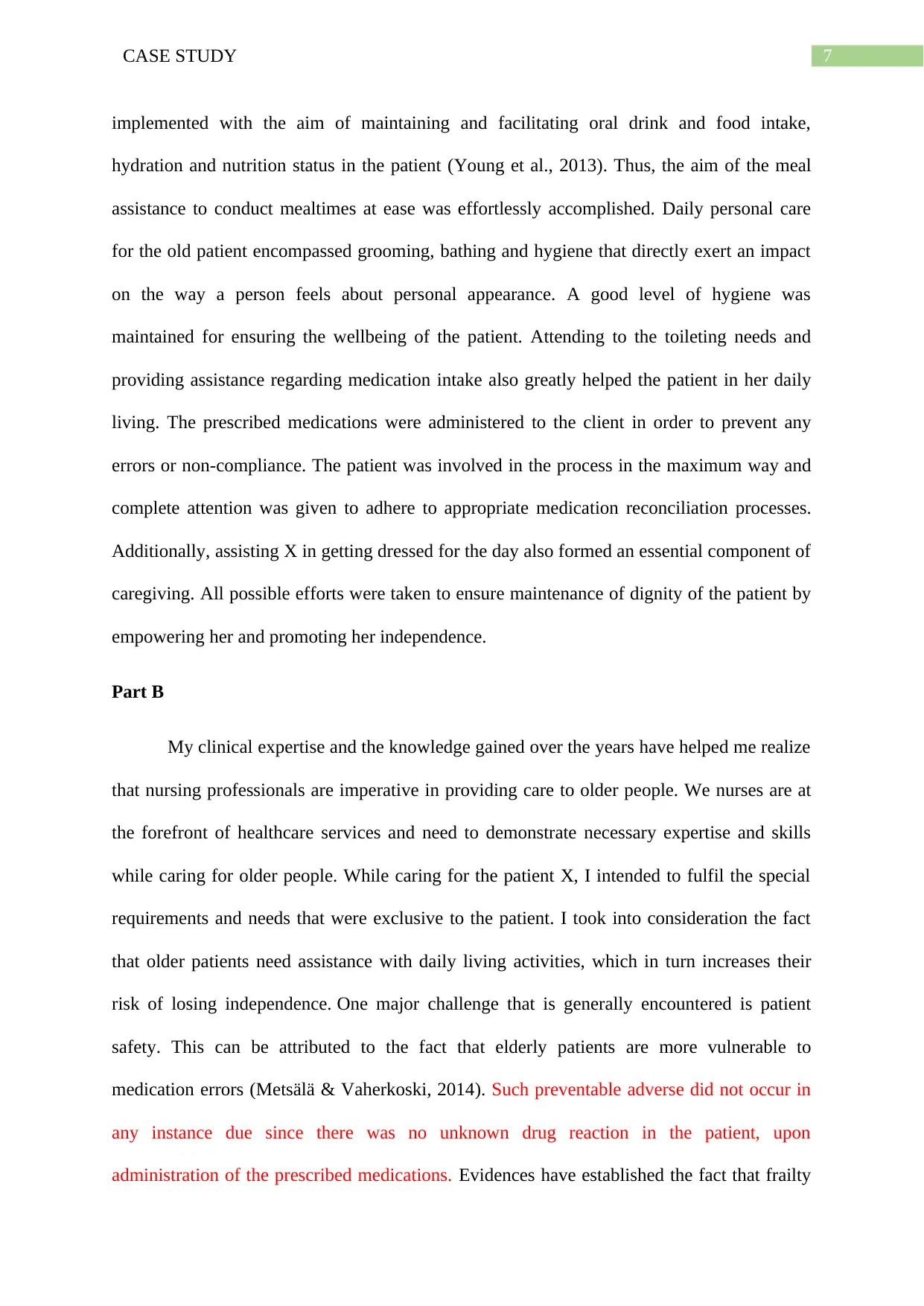
7CASE STUDY
implemented with the aim of maintaining and facilitating oral drink and food intake,
hydration and nutrition status in the patient (Young et al., 2013). Thus, the aim of the meal
assistance to conduct mealtimes at ease was effortlessly accomplished. Daily personal care
for the old patient encompassed grooming, bathing and hygiene that directly exert an impact
on the way a person feels about personal appearance. A good level of hygiene was
maintained for ensuring the wellbeing of the patient. Attending to the toileting needs and
providing assistance regarding medication intake also greatly helped the patient in her daily
living. The prescribed medications were administered to the client in order to prevent any
errors or non-compliance. The patient was involved in the process in the maximum way and
complete attention was given to adhere to appropriate medication reconciliation processes.
Additionally, assisting X in getting dressed for the day also formed an essential component of
caregiving. All possible efforts were taken to ensure maintenance of dignity of the patient by
empowering her and promoting her independence.
Part B
My clinical expertise and the knowledge gained over the years have helped me realize
that nursing professionals are imperative in providing care to older people. We nurses are at
the forefront of healthcare services and need to demonstrate necessary expertise and skills
while caring for older people. While caring for the patient X, I intended to fulfil the special
requirements and needs that were exclusive to the patient. I took into consideration the fact
that older patients need assistance with daily living activities, which in turn increases their
risk of losing independence. One major challenge that is generally encountered is patient
safety. This can be attributed to the fact that elderly patients are more vulnerable to
medication errors (Metsälä & Vaherkoski, 2014). Such preventable adverse did not occur in
any instance due since there was no unknown drug reaction in the patient, upon
administration of the prescribed medications. Evidences have established the fact that frailty
implemented with the aim of maintaining and facilitating oral drink and food intake,
hydration and nutrition status in the patient (Young et al., 2013). Thus, the aim of the meal
assistance to conduct mealtimes at ease was effortlessly accomplished. Daily personal care
for the old patient encompassed grooming, bathing and hygiene that directly exert an impact
on the way a person feels about personal appearance. A good level of hygiene was
maintained for ensuring the wellbeing of the patient. Attending to the toileting needs and
providing assistance regarding medication intake also greatly helped the patient in her daily
living. The prescribed medications were administered to the client in order to prevent any
errors or non-compliance. The patient was involved in the process in the maximum way and
complete attention was given to adhere to appropriate medication reconciliation processes.
Additionally, assisting X in getting dressed for the day also formed an essential component of
caregiving. All possible efforts were taken to ensure maintenance of dignity of the patient by
empowering her and promoting her independence.
Part B
My clinical expertise and the knowledge gained over the years have helped me realize
that nursing professionals are imperative in providing care to older people. We nurses are at
the forefront of healthcare services and need to demonstrate necessary expertise and skills
while caring for older people. While caring for the patient X, I intended to fulfil the special
requirements and needs that were exclusive to the patient. I took into consideration the fact
that older patients need assistance with daily living activities, which in turn increases their
risk of losing independence. One major challenge that is generally encountered is patient
safety. This can be attributed to the fact that elderly patients are more vulnerable to
medication errors (Metsälä & Vaherkoski, 2014). Such preventable adverse did not occur in
any instance due since there was no unknown drug reaction in the patient, upon
administration of the prescribed medications. Evidences have established the fact that frailty

8CASE STUDY
in older people acts as a biologic syndrome of reduce resistance to a range of stressors that
lead to cumulative decline in the physiologic system and causes vulnerability to adverse
health outcomes (Joseph et al., 2014). Increased tendency for medication errors has also been
recognised as a major indicator that associates frailty with mortality (Kwan et al., 2013).
However, the client did not pose any such challenges in treatment.
The initial behavioural and psychological symptoms presented by the client
comprised of agitation and mood disorders. I tried to counteract the problem by adopting a
person-centred care approach where I attempted to obtain a sound understanding of her
behaviour by facilitating effective communication to find solutions to the problem. Showing
respect towards the functional status and dignity of the client proved successful in meeting
her preferences and demands. Implementation of the cognitive behavioural therapy,
assistance with meals and proper medication administration showed significant positive
impacts on the overall health and wellbeing of the patient. The benefits were observed few
weeks after beginning the treatment and showed that the patient had significantly improved in
her cognitive functioning skills, as evident through the results of the Mini-Mental State
Examination. She showed remarkable improvements in her visuospatial abilities and
language skills, thereby enhancing her quality of life. Her responses suggested that she had
positive experiences in the non-threatening and supportive environment and showed an
improvement in her concentration, mood and confidence. Data reports suggest that
prescription of more than three drugs are quite prevalent in the elderly that directly interferes
with their memory (Hwang et al., 2013). Medication adherence is a common issue
encountered in dementia care, where administration of multiple drugs for the health disorders
present problems. However, the patient did not create the most common challenges
associated with forgetting about drug intake, and showed strict adherence to the medication
in older people acts as a biologic syndrome of reduce resistance to a range of stressors that
lead to cumulative decline in the physiologic system and causes vulnerability to adverse
health outcomes (Joseph et al., 2014). Increased tendency for medication errors has also been
recognised as a major indicator that associates frailty with mortality (Kwan et al., 2013).
However, the client did not pose any such challenges in treatment.
The initial behavioural and psychological symptoms presented by the client
comprised of agitation and mood disorders. I tried to counteract the problem by adopting a
person-centred care approach where I attempted to obtain a sound understanding of her
behaviour by facilitating effective communication to find solutions to the problem. Showing
respect towards the functional status and dignity of the client proved successful in meeting
her preferences and demands. Implementation of the cognitive behavioural therapy,
assistance with meals and proper medication administration showed significant positive
impacts on the overall health and wellbeing of the patient. The benefits were observed few
weeks after beginning the treatment and showed that the patient had significantly improved in
her cognitive functioning skills, as evident through the results of the Mini-Mental State
Examination. She showed remarkable improvements in her visuospatial abilities and
language skills, thereby enhancing her quality of life. Her responses suggested that she had
positive experiences in the non-threatening and supportive environment and showed an
improvement in her concentration, mood and confidence. Data reports suggest that
prescription of more than three drugs are quite prevalent in the elderly that directly interferes
with their memory (Hwang et al., 2013). Medication adherence is a common issue
encountered in dementia care, where administration of multiple drugs for the health disorders
present problems. However, the patient did not create the most common challenges
associated with forgetting about drug intake, and showed strict adherence to the medication
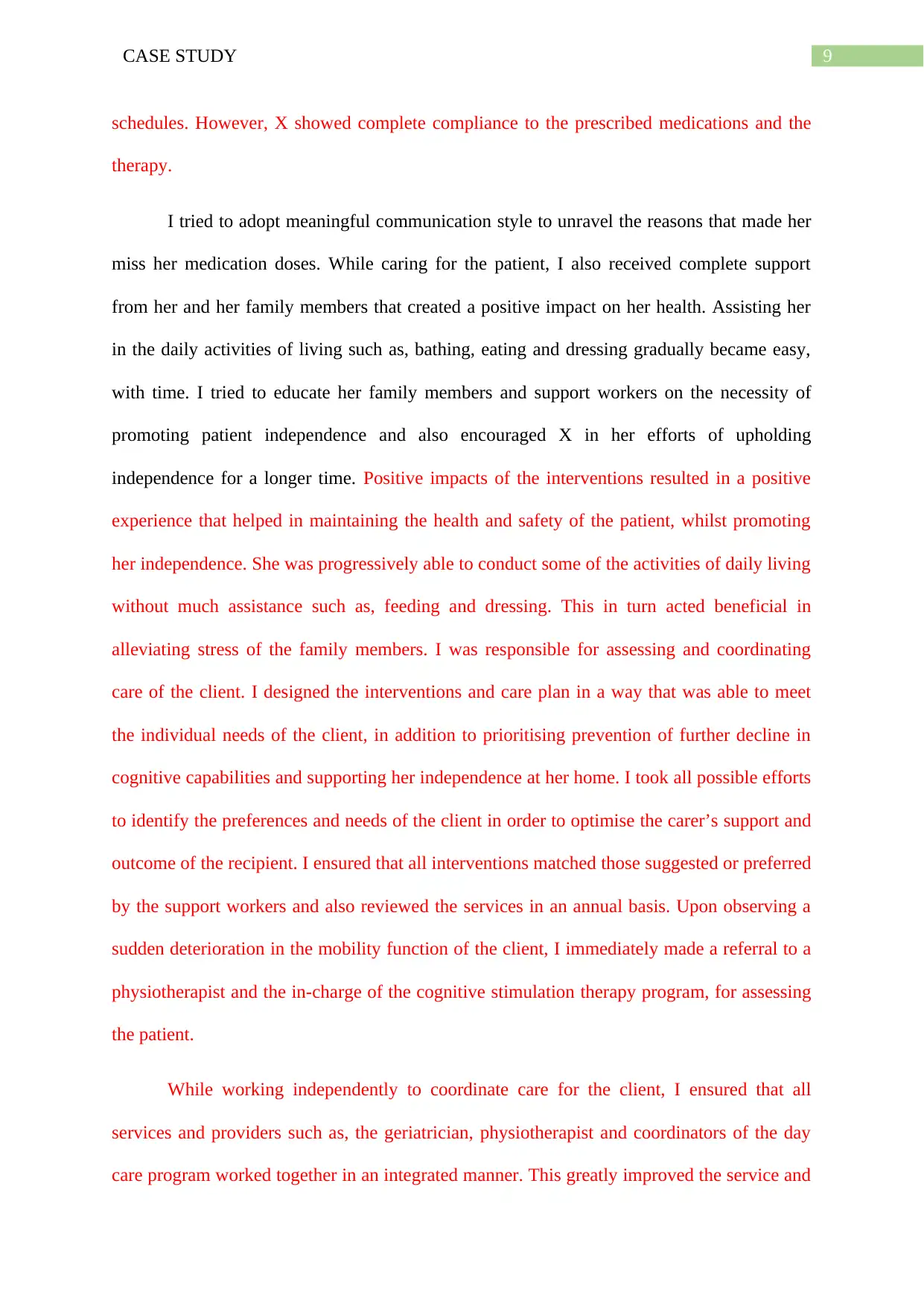
9CASE STUDY
schedules. However, X showed complete compliance to the prescribed medications and the
therapy.
I tried to adopt meaningful communication style to unravel the reasons that made her
miss her medication doses. While caring for the patient, I also received complete support
from her and her family members that created a positive impact on her health. Assisting her
in the daily activities of living such as, bathing, eating and dressing gradually became easy,
with time. I tried to educate her family members and support workers on the necessity of
promoting patient independence and also encouraged X in her efforts of upholding
independence for a longer time. Positive impacts of the interventions resulted in a positive
experience that helped in maintaining the health and safety of the patient, whilst promoting
her independence. She was progressively able to conduct some of the activities of daily living
without much assistance such as, feeding and dressing. This in turn acted beneficial in
alleviating stress of the family members. I was responsible for assessing and coordinating
care of the client. I designed the interventions and care plan in a way that was able to meet
the individual needs of the client, in addition to prioritising prevention of further decline in
cognitive capabilities and supporting her independence at her home. I took all possible efforts
to identify the preferences and needs of the client in order to optimise the carer’s support and
outcome of the recipient. I ensured that all interventions matched those suggested or preferred
by the support workers and also reviewed the services in an annual basis. Upon observing a
sudden deterioration in the mobility function of the client, I immediately made a referral to a
physiotherapist and the in-charge of the cognitive stimulation therapy program, for assessing
the patient.
While working independently to coordinate care for the client, I ensured that all
services and providers such as, the geriatrician, physiotherapist and coordinators of the day
care program worked together in an integrated manner. This greatly improved the service and
schedules. However, X showed complete compliance to the prescribed medications and the
therapy.
I tried to adopt meaningful communication style to unravel the reasons that made her
miss her medication doses. While caring for the patient, I also received complete support
from her and her family members that created a positive impact on her health. Assisting her
in the daily activities of living such as, bathing, eating and dressing gradually became easy,
with time. I tried to educate her family members and support workers on the necessity of
promoting patient independence and also encouraged X in her efforts of upholding
independence for a longer time. Positive impacts of the interventions resulted in a positive
experience that helped in maintaining the health and safety of the patient, whilst promoting
her independence. She was progressively able to conduct some of the activities of daily living
without much assistance such as, feeding and dressing. This in turn acted beneficial in
alleviating stress of the family members. I was responsible for assessing and coordinating
care of the client. I designed the interventions and care plan in a way that was able to meet
the individual needs of the client, in addition to prioritising prevention of further decline in
cognitive capabilities and supporting her independence at her home. I took all possible efforts
to identify the preferences and needs of the client in order to optimise the carer’s support and
outcome of the recipient. I ensured that all interventions matched those suggested or preferred
by the support workers and also reviewed the services in an annual basis. Upon observing a
sudden deterioration in the mobility function of the client, I immediately made a referral to a
physiotherapist and the in-charge of the cognitive stimulation therapy program, for assessing
the patient.
While working independently to coordinate care for the client, I ensured that all
services and providers such as, the geriatrician, physiotherapist and coordinators of the day
care program worked together in an integrated manner. This greatly improved the service and
Secure Best Marks with AI Grader
Need help grading? Try our AI Grader for instant feedback on your assignments.

10CASE STUDY
quality value by well ensuring that all clients gain an advantage from precise mix of health
and allied care services that are available.
quality value by well ensuring that all clients gain an advantage from precise mix of health
and allied care services that are available.

11CASE STUDY
References
Aguirre, E., Hoare, Z., Streater, A., Spector, A., Woods, B., Hoe, J., & Orrell, M. (2013).
Cognitive stimulation therapy (CST) for people with dementia—who benefits
most?. International journal of geriatric psychiatry, 28(3), 284-290.
Fager, S. K., & Burnfield, J. M. (2014). Patients' experiences with technology during
inpatient rehabilitation: opportunities to support independence and therapeutic
engagement. Disability and Rehabilitation: Assistive Technology, 9(2), 121-127.
Griffiths, A., Knight, A., Harwood, R., & Gladman, J. R. (2013). Preparation to care for
confused older patients in general hospitals: a study of UK health professionals. Age
and ageing, 43(4), 521-527.
Hsieh, S., McGrory, S., Leslie, F., Dawson, K., Ahmed, S., Butler, C. R., ... & Hodges, J. R.
(2015). The Mini-Addenbrooke's Cognitive Examination: a new assessment tool for
dementia. Dementia and geriatric cognitive disorders, 39(1-2), 1-11.
Hwang, U., Shah, M. N., Han, J. H., Carpenter, C. R., Siu, A. L., & Adams, J. G. (2013).
Transforming emergency care for older adults. Health Affairs, 32(12), 2116-2121.
Joseph, B., Pandit, V., Zangbar, B., Kulvatunyou, N., Hashmi, A., Green, D. J., ... & Friese,
R. S. (2014). Superiority of frailty over age in predicting outcomes among geriatric
trauma patients: a prospective analysis. JAMA surgery, 149(8), 766-772.
Kessing, L. V., Gerds, T. A., Feldt-Rasmussen, B., Andersen, P. K., & Licht, R. W. (2015).
Use of lithium and anticonvulsants and the rate of chronic kidney disease: a
nationwide population-based study. JAMA psychiatry, 72(12), 1182-1191.
Kozyraki, R., & Cases, O. (2013). Vitamin B12 absorption: mammalian physiology and
acquired and inherited disorders. Biochimie, 95(5), 1002-1007.
References
Aguirre, E., Hoare, Z., Streater, A., Spector, A., Woods, B., Hoe, J., & Orrell, M. (2013).
Cognitive stimulation therapy (CST) for people with dementia—who benefits
most?. International journal of geriatric psychiatry, 28(3), 284-290.
Fager, S. K., & Burnfield, J. M. (2014). Patients' experiences with technology during
inpatient rehabilitation: opportunities to support independence and therapeutic
engagement. Disability and Rehabilitation: Assistive Technology, 9(2), 121-127.
Griffiths, A., Knight, A., Harwood, R., & Gladman, J. R. (2013). Preparation to care for
confused older patients in general hospitals: a study of UK health professionals. Age
and ageing, 43(4), 521-527.
Hsieh, S., McGrory, S., Leslie, F., Dawson, K., Ahmed, S., Butler, C. R., ... & Hodges, J. R.
(2015). The Mini-Addenbrooke's Cognitive Examination: a new assessment tool for
dementia. Dementia and geriatric cognitive disorders, 39(1-2), 1-11.
Hwang, U., Shah, M. N., Han, J. H., Carpenter, C. R., Siu, A. L., & Adams, J. G. (2013).
Transforming emergency care for older adults. Health Affairs, 32(12), 2116-2121.
Joseph, B., Pandit, V., Zangbar, B., Kulvatunyou, N., Hashmi, A., Green, D. J., ... & Friese,
R. S. (2014). Superiority of frailty over age in predicting outcomes among geriatric
trauma patients: a prospective analysis. JAMA surgery, 149(8), 766-772.
Kessing, L. V., Gerds, T. A., Feldt-Rasmussen, B., Andersen, P. K., & Licht, R. W. (2015).
Use of lithium and anticonvulsants and the rate of chronic kidney disease: a
nationwide population-based study. JAMA psychiatry, 72(12), 1182-1191.
Kozyraki, R., & Cases, O. (2013). Vitamin B12 absorption: mammalian physiology and
acquired and inherited disorders. Biochimie, 95(5), 1002-1007.
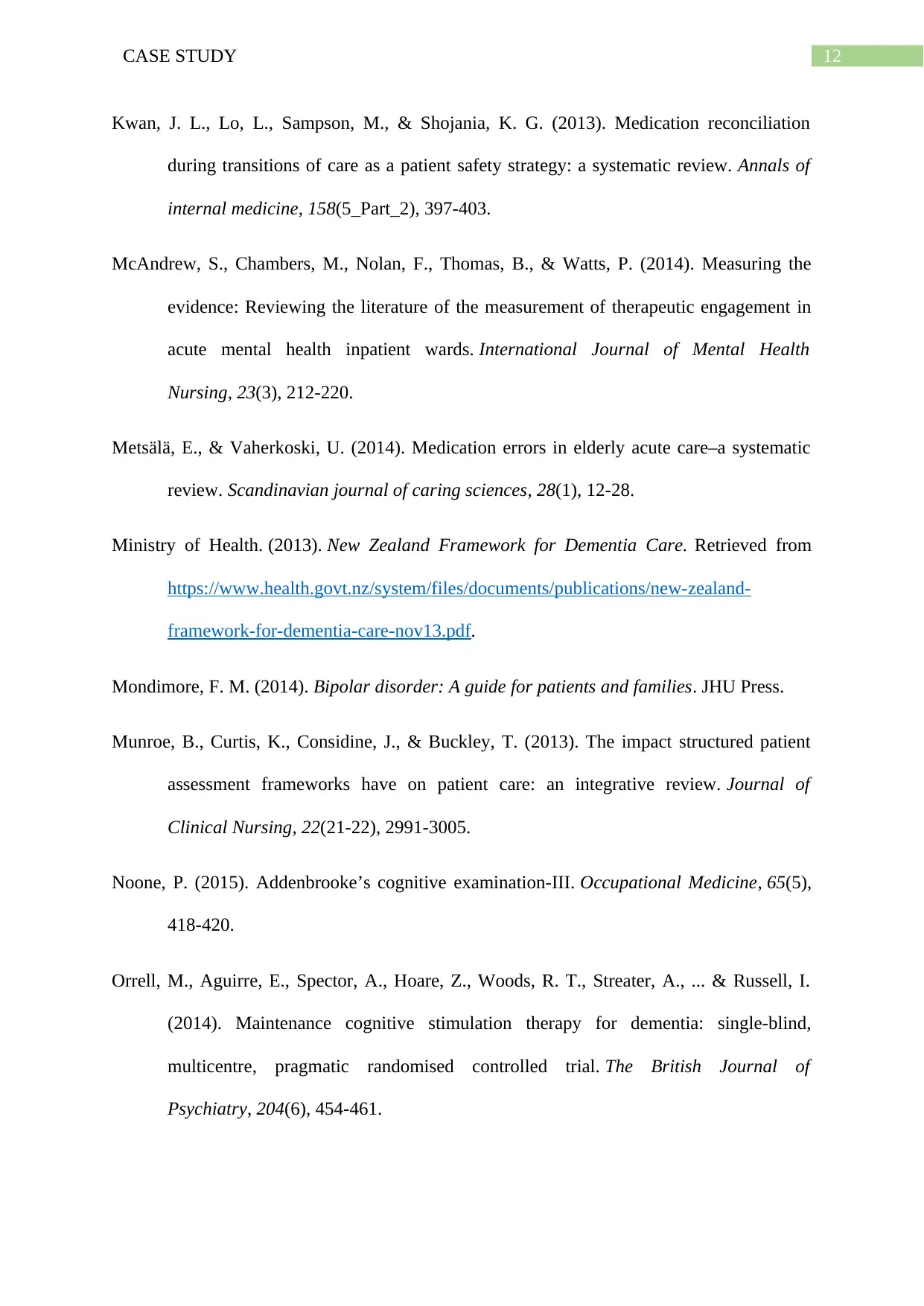
12CASE STUDY
Kwan, J. L., Lo, L., Sampson, M., & Shojania, K. G. (2013). Medication reconciliation
during transitions of care as a patient safety strategy: a systematic review. Annals of
internal medicine, 158(5_Part_2), 397-403.
McAndrew, S., Chambers, M., Nolan, F., Thomas, B., & Watts, P. (2014). Measuring the
evidence: Reviewing the literature of the measurement of therapeutic engagement in
acute mental health inpatient wards. International Journal of Mental Health
Nursing, 23(3), 212-220.
Metsälä, E., & Vaherkoski, U. (2014). Medication errors in elderly acute care–a systematic
review. Scandinavian journal of caring sciences, 28(1), 12-28.
Ministry of Health. (2013). New Zealand Framework for Dementia Care. Retrieved from
https://www.health.govt.nz/system/files/documents/publications/new-zealand-
framework-for-dementia-care-nov13.pdf.
Mondimore, F. M. (2014). Bipolar disorder: A guide for patients and families. JHU Press.
Munroe, B., Curtis, K., Considine, J., & Buckley, T. (2013). The impact structured patient
assessment frameworks have on patient care: an integrative review. Journal of
Clinical Nursing, 22(21-22), 2991-3005.
Noone, P. (2015). Addenbrooke’s cognitive examination-III. Occupational Medicine, 65(5),
418-420.
Orrell, M., Aguirre, E., Spector, A., Hoare, Z., Woods, R. T., Streater, A., ... & Russell, I.
(2014). Maintenance cognitive stimulation therapy for dementia: single-blind,
multicentre, pragmatic randomised controlled trial. The British Journal of
Psychiatry, 204(6), 454-461.
Kwan, J. L., Lo, L., Sampson, M., & Shojania, K. G. (2013). Medication reconciliation
during transitions of care as a patient safety strategy: a systematic review. Annals of
internal medicine, 158(5_Part_2), 397-403.
McAndrew, S., Chambers, M., Nolan, F., Thomas, B., & Watts, P. (2014). Measuring the
evidence: Reviewing the literature of the measurement of therapeutic engagement in
acute mental health inpatient wards. International Journal of Mental Health
Nursing, 23(3), 212-220.
Metsälä, E., & Vaherkoski, U. (2014). Medication errors in elderly acute care–a systematic
review. Scandinavian journal of caring sciences, 28(1), 12-28.
Ministry of Health. (2013). New Zealand Framework for Dementia Care. Retrieved from
https://www.health.govt.nz/system/files/documents/publications/new-zealand-
framework-for-dementia-care-nov13.pdf.
Mondimore, F. M. (2014). Bipolar disorder: A guide for patients and families. JHU Press.
Munroe, B., Curtis, K., Considine, J., & Buckley, T. (2013). The impact structured patient
assessment frameworks have on patient care: an integrative review. Journal of
Clinical Nursing, 22(21-22), 2991-3005.
Noone, P. (2015). Addenbrooke’s cognitive examination-III. Occupational Medicine, 65(5),
418-420.
Orrell, M., Aguirre, E., Spector, A., Hoare, Z., Woods, R. T., Streater, A., ... & Russell, I.
(2014). Maintenance cognitive stimulation therapy for dementia: single-blind,
multicentre, pragmatic randomised controlled trial. The British Journal of
Psychiatry, 204(6), 454-461.
Paraphrase This Document
Need a fresh take? Get an instant paraphrase of this document with our AI Paraphraser
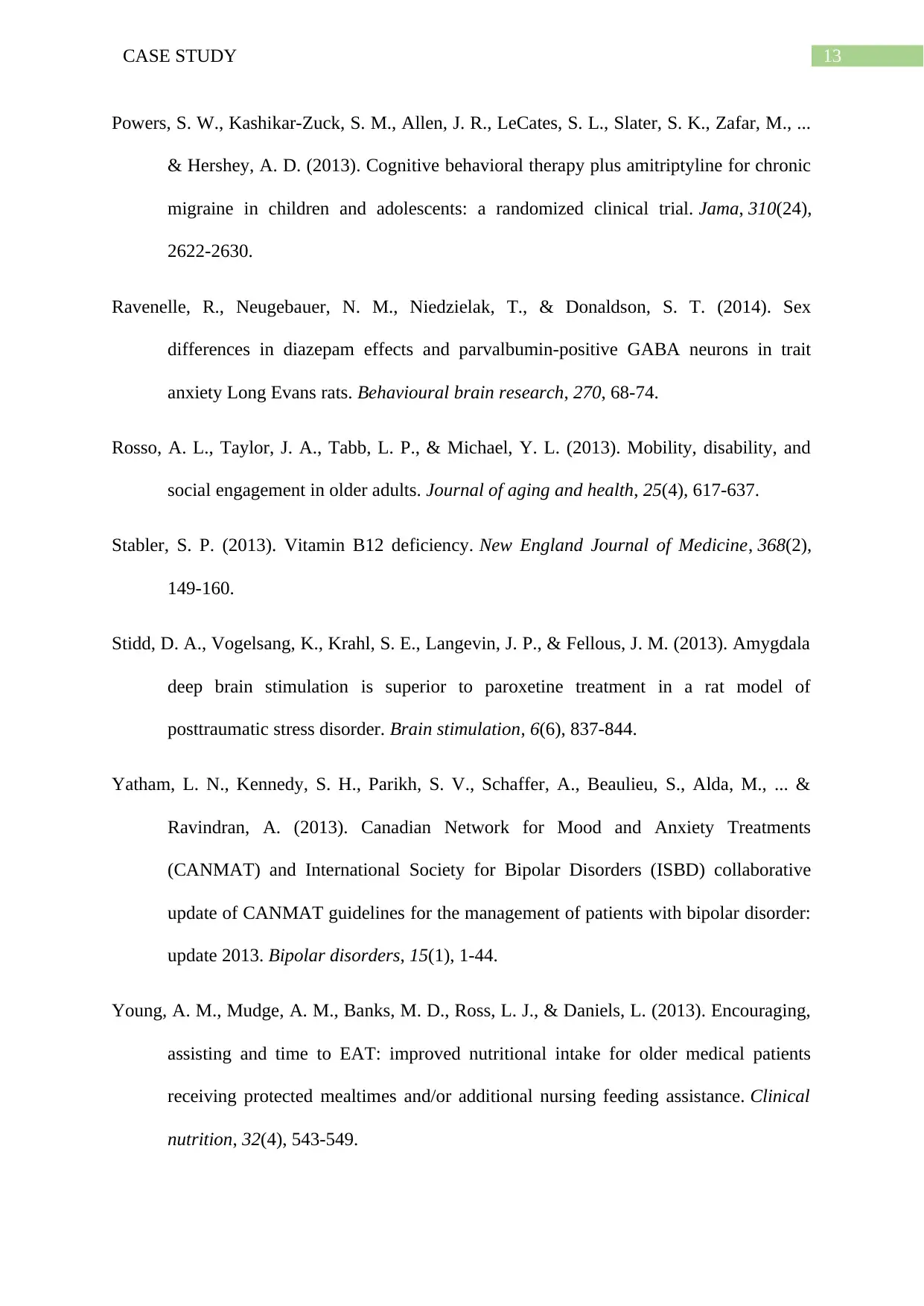
13CASE STUDY
Powers, S. W., Kashikar-Zuck, S. M., Allen, J. R., LeCates, S. L., Slater, S. K., Zafar, M., ...
& Hershey, A. D. (2013). Cognitive behavioral therapy plus amitriptyline for chronic
migraine in children and adolescents: a randomized clinical trial. Jama, 310(24),
2622-2630.
Ravenelle, R., Neugebauer, N. M., Niedzielak, T., & Donaldson, S. T. (2014). Sex
differences in diazepam effects and parvalbumin-positive GABA neurons in trait
anxiety Long Evans rats. Behavioural brain research, 270, 68-74.
Rosso, A. L., Taylor, J. A., Tabb, L. P., & Michael, Y. L. (2013). Mobility, disability, and
social engagement in older adults. Journal of aging and health, 25(4), 617-637.
Stabler, S. P. (2013). Vitamin B12 deficiency. New England Journal of Medicine, 368(2),
149-160.
Stidd, D. A., Vogelsang, K., Krahl, S. E., Langevin, J. P., & Fellous, J. M. (2013). Amygdala
deep brain stimulation is superior to paroxetine treatment in a rat model of
posttraumatic stress disorder. Brain stimulation, 6(6), 837-844.
Yatham, L. N., Kennedy, S. H., Parikh, S. V., Schaffer, A., Beaulieu, S., Alda, M., ... &
Ravindran, A. (2013). Canadian Network for Mood and Anxiety Treatments
(CANMAT) and International Society for Bipolar Disorders (ISBD) collaborative
update of CANMAT guidelines for the management of patients with bipolar disorder:
update 2013. Bipolar disorders, 15(1), 1-44.
Young, A. M., Mudge, A. M., Banks, M. D., Ross, L. J., & Daniels, L. (2013). Encouraging,
assisting and time to EAT: improved nutritional intake for older medical patients
receiving protected mealtimes and/or additional nursing feeding assistance. Clinical
nutrition, 32(4), 543-549.
Powers, S. W., Kashikar-Zuck, S. M., Allen, J. R., LeCates, S. L., Slater, S. K., Zafar, M., ...
& Hershey, A. D. (2013). Cognitive behavioral therapy plus amitriptyline for chronic
migraine in children and adolescents: a randomized clinical trial. Jama, 310(24),
2622-2630.
Ravenelle, R., Neugebauer, N. M., Niedzielak, T., & Donaldson, S. T. (2014). Sex
differences in diazepam effects and parvalbumin-positive GABA neurons in trait
anxiety Long Evans rats. Behavioural brain research, 270, 68-74.
Rosso, A. L., Taylor, J. A., Tabb, L. P., & Michael, Y. L. (2013). Mobility, disability, and
social engagement in older adults. Journal of aging and health, 25(4), 617-637.
Stabler, S. P. (2013). Vitamin B12 deficiency. New England Journal of Medicine, 368(2),
149-160.
Stidd, D. A., Vogelsang, K., Krahl, S. E., Langevin, J. P., & Fellous, J. M. (2013). Amygdala
deep brain stimulation is superior to paroxetine treatment in a rat model of
posttraumatic stress disorder. Brain stimulation, 6(6), 837-844.
Yatham, L. N., Kennedy, S. H., Parikh, S. V., Schaffer, A., Beaulieu, S., Alda, M., ... &
Ravindran, A. (2013). Canadian Network for Mood and Anxiety Treatments
(CANMAT) and International Society for Bipolar Disorders (ISBD) collaborative
update of CANMAT guidelines for the management of patients with bipolar disorder:
update 2013. Bipolar disorders, 15(1), 1-44.
Young, A. M., Mudge, A. M., Banks, M. D., Ross, L. J., & Daniels, L. (2013). Encouraging,
assisting and time to EAT: improved nutritional intake for older medical patients
receiving protected mealtimes and/or additional nursing feeding assistance. Clinical
nutrition, 32(4), 543-549.

14CASE STUDY
1 out of 15
Your All-in-One AI-Powered Toolkit for Academic Success.
+13062052269
info@desklib.com
Available 24*7 on WhatsApp / Email
![[object Object]](/_next/static/media/star-bottom.7253800d.svg)
Unlock your academic potential
© 2024 | Zucol Services PVT LTD | All rights reserved.
